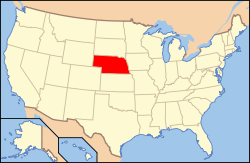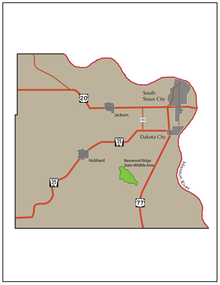Dakota County, Nebraska
| Dakota County, Nebraska | |
|---|---|
|
Dakota County courthouse in Dakota City | |
 Location in the U.S. state of Nebraska | |
 Nebraska's location in the U.S. | |
| Founded | March 7, 1855 |
| Named for | Dakota people |
| Seat | Dakota City |
| Largest city | South Sioux City |
| Area | |
| • Total | 267 sq mi (692 km2) |
| • Land | 264 sq mi (684 km2) |
| • Water | 3.2 sq mi (8 km2), 1.2% |
| Population (est.) | |
| • (2015) | 20,781 |
| • Density | 78/sq mi (30/km²) |
| Congressional district | 3rd |
| Time zone | Central: UTC-6/-5 |
| Website |
www |
Dakota County is a county in the U.S. state of Nebraska. As of the 2010 census, the population was 21,006.[1] Its county seat is Dakota City.[2]
Dakota County is part of the Sioux City, IA–NE–SD Metropolitan Statistical Area.
In the Nebraska license plate system, Dakota County is represented by the prefix 70 (it had the 70th-largest number of vehicles registered in the county when the license plate system was established in 1922). In August 2009, the Dakota County Board of Commissioners reversed an decision to abandon this system for alphanumeric plates upon introduction of new license plates in 2011.[3] Douglas, Lancaster, and Sarpy Counties remain the only counties with alphanumeric plates in the state.[4]
History
Succeeding cultures of indigenous peoples lived along the Missouri River for thousands of years. By 1775, the Omaha people had migrated west of the Missouri, where they established a major settlement, which they called Ton-wa-tonga, meaning the Big Village.[5] It had about 1100 residents. From here, the Omaha controlled fur trading on the upper Missouri River with other tribes and with French-Canadian traders, often called voyageurs. The Omaha were the first of the Northern Plains tribes to have adopted an equestrian culture.[5]
Dakota County was formed by European-American settlers in 1855. They named it after the historic Dakota Sioux tribe, who were powerful in the area of Nebraska and South Dakota.[6] By this time, the Omaha were concentrated further south in what became the state of Nebraska.
In 1885, the county went to the United States Supreme Court in Dakota County v. Glidden over a dispute with issuing bonds.
Geography
According to the U.S. Census Bureau, the county has an area of 267 square miles (690 km2), of which 264 square miles (680 km2) is land and 3.2 square miles (8.3 km2) (1.2%) is water.[7] It is the second-smallest county in Nebraska by area.
The county is separated from South Dakota on the northeast and Iowa on the east by the Missouri River.[8] The surface consists of rolling prairies and bottom lands.[8]

Major highways
Adjacent counties
- Union County, South Dakota - north
- Woodbury County, Iowa - east
- Thurston County, Nebraska - south
- Dixon County, Nebraska - west
Demographics
| Historical population | |||
|---|---|---|---|
| Census | Pop. | %± | |
| 1860 | 819 | — | |
| 1870 | 2,040 | 149.1% | |
| 1880 | 3,213 | 57.5% | |
| 1890 | 5,386 | 67.6% | |
| 1900 | 6,286 | 16.7% | |
| 1910 | 6,564 | 4.4% | |
| 1920 | 7,694 | 17.2% | |
| 1930 | 9,505 | 23.5% | |
| 1940 | 9,836 | 3.5% | |
| 1950 | 10,401 | 5.7% | |
| 1960 | 12,168 | 17.0% | |
| 1970 | 13,137 | 8.0% | |
| 1980 | 16,573 | 26.2% | |
| 1990 | 16,742 | 1.0% | |
| 2000 | 20,253 | 21.0% | |
| 2010 | 21,006 | 3.7% | |
| Est. 2015 | 20,781 | [9] | −1.1% |
| U.S. Decennial Census[10] 1790-1960[11] 1900-1990[12] 1990-2000[13] 2010-2013[1] | |||
As of the census of 2000, there were 20,253 people, 7,095 households, and 5,087 families residing in the county. The population density was 77 people per square mile (30/km²). There were 7,528 housing units at an average density of 28 per square mile (11/km²). The racial makeup of the county was 78.84% White, 0.62% Black or African American, 1.86% Native American, 3.08% Asian, 0.06% Pacific Islander, 12.91% from other races, and 2.62% from two or more races. 22.62% of the population were Hispanic or Latino of any race. 28.0% were of German and 10.5% Irish ancestry according to the 2000 census.
There were 7,095 households out of which 39.90% had children under the age of 18 living with them, 54.60% were married couples living together, 11.90% had a female householder with no husband present, and 28.30% were non-families. 22.90% of all households were made up of individuals and 9.00% had someone living alone who was 65 years of age or older. The average household size was 2.81 and the average family size was 3.30.
In the county the population was spread out with 30.50% under the age of 18, 10.10% from 18 to 24, 29.40% from 25 to 44, 20.10% from 45 to 64, and 9.90% who were 65 years of age or older. The median age was 31 years. For every 100 females there were 99.70 males. For every 100 females age 18 and over, there were 97.10 males.
The median income for a household in the county was $38,834, and the median income for a family was $43,702. Males had a median income of $28,341 versus $22,035 for females. The per capita income for the county was $16,125. About 9.20% of families and 11.40% of the population were below the poverty line, including 14.60% of those under age 18 and 8.60% of those age 65 or over.
Communities
Cities
- Dakota City (county seat)
- South Sioux City
Villages
Unincorporated communities
See also
References
- 1 2 "State & County QuickFacts". United States Census Bureau. Retrieved October 24, 2014.
- ↑ "Find a County". National Association of Counties. Archived from the original on May 31, 2011. Retrieved 2011-06-07.
- ↑ Dakota County license plates to keep No.70 Sioux City Journal August 18, 2009
- ↑ Plate math: 70 follows 1, 2, 59 Omaha World-Herald June 8, 2009
- 1 2 Paulette W. Campbell, "Ancestral Bones: Reinterpreting the Past of the Omaha", Humanities, November/December 2002, Volume 23/Number 6, accessed 26 August 2011
- ↑ "Dakota County, Nebraska", National Association of County Executives, Retrieved on March 14, 2008.
- ↑ "2010 Census Gazetteer Files". United States Census Bureau. August 22, 2012. Retrieved December 6, 2014.
- 1 2
 Ripley, George; Dana, Charles A., eds. (1879). "Dakota. II. A N. E. county of Nebraska". The American Cyclopædia.
Ripley, George; Dana, Charles A., eds. (1879). "Dakota. II. A N. E. county of Nebraska". The American Cyclopædia.
- ↑ "County Totals Dataset: Population, Population Change and Estimated Components of Population Change: April 1, 2010 to July 1, 2015". Retrieved July 2, 2016.
- ↑ "U.S. Decennial Census". United States Census Bureau. Archived from the original on May 11, 2015. Retrieved December 6, 2014.
- ↑ "Historical Census Browser". University of Virginia Library. Retrieved December 6, 2014.
- ↑ "Population of Counties by Decennial Census: 1900 to 1990". United States Census Bureau. Retrieved December 6, 2014.
- ↑ "Census 2000 PHC-T-4. Ranking Tables for Counties: 1990 and 2000" (PDF). United States Census Bureau. Retrieved December 6, 2014.
 |
Union County, South Dakota |  | ||
| Dixon Count | |
Woodbury County, Iowa | ||
| ||||
| | ||||
| Thurston County |
Coordinates: 42°23′N 96°34′W / 42.39°N 96.56°W